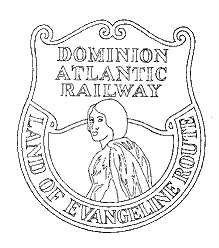
Cumberland County is a county in the Canadian province of Nova Scotia.

Springhill is a community located in central Cumberland County, Nova Scotia, Canada.

Sackville is a community in southeastern New Brunswick, Canada. It held town status prior to 2023.

The Intercolonial Railway of Canada, also referred to as the Intercolonial Railway (ICR), was a historic Canadian railway that operated from 1872 to 1918, when it became part of Canadian National Railways. As the railway was also completely owned and controlled by the Government of Canada, the Intercolonial was also one of Canada's first Crown corporations.

The Prince Edward Island Railway (PEIR) was a historic Canadian railway in Prince Edward Island (PEI). The railway ran tip-to-tip on the island, from Tignish in the west to Elmira in the east, with major spurs serving Borden-Carleton's train ferry dock, the capital in Charlottetown, Montague and Georgetown and the original eastern terminus at Souris. A major spur from Charlottetown served Murray Harbour on the south coast.

Springhill mining disaster may refer to any of three deadly Canadian mining disasters that occurred in 1891, 1956, and 1958 in different mines within the Springhill coalfield, near the town of Springhill in Cumberland County, Nova Scotia. In the 1891 accident, 125 died; in 1956, 39 were killed; and in 1958, there were 75 miners killed.

The Dominion Atlantic Railway was a historic railway which operated in the western part of Nova Scotia in Canada, primarily through an agricultural district known as the Annapolis Valley.

The Windsor and Hantsport Railway was a 56-mile (90.1 km) railway line in Nova Scotia between Windsor Junction and New Minas with a spur at Windsor which runs several miles east, serving two gypsum quarries located at Wentworth Creek and Mantua. It suspended operations in 2011.

The Sydney and Louisburg Railway (S&L) was a Canadian railway. Built to transport coal from various mines to the ports of Sydney and Louisbourg, the S&L operated in the eastern part of Cape Breton County, Nova Scotia. The railway uses a slightly different spelling for the town of "Louisbourg".

The Halifax and South Western Railway was a historic Canadian railway operating in the province of Nova Scotia.

Parrsboro is a community located in Cumberland County, Nova Scotia, Canada.

Joggins is a rural community located in western Cumberland County, Nova Scotia, Canada. On July 7, 2008 a 15-km length of the coast constituting the Joggins Fossil Cliffs was officially inscribed on the World Heritage List.
Wallace Station is a small farming community located in Cumberland County, Nova Scotia, Canada.

The Dominion Steel and Coal Corporation was a Canadian coal mining and steel manufacturing company.
Windsor Junction is a suburban community in Halifax Regional Municipality, Nova Scotia, Canada. It is located approximately 22 km (14 mi) north west of Downtown Halifax and approximately 3 km (1.9 mi) north of the Bedford Basin near the communities of Fall River, Lower Sackville, and Waverley.
Oxford Junction is a Canadian rural community in Cumberland County, Nova Scotia, which lies approximately 5 kilometers to the southwest of the town of Oxford.
The Cumberland Railway and Coal Company is a defunct Canadian industrial company with interests in coal mines in Springhill, Nova Scotia, and a railway that operated from Springhill Junction to Parrsboro.
Pugwash Junction is a Canadian rural community in Cumberland County, Nova Scotia.

Springhill Coal Mining is a National Historic Site of Canada located on the corner of Industrial Park Drive and Memorial Crescent in Springhill, Nova Scotia. The Historic Site, designated in 1998, consists of a museum and the land that once contained the Springhill Coal Mines. Springhill was once one of the most important coalfields in Canada, along with those in Pictou and Cape Breton. Springhill coal was shipped and marketed throughout the Maritimes and Quebec. The surviving mining features in Springhill are among the most complete in Canada. The Springhill Mines were made infamous by a number of disasters that occurred underground, including the 1891 explosion, the 1956 explosion and the 1958 bump.














